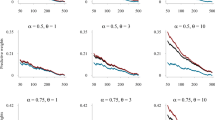Abstract
We apply a Bayesian approach to the problem of prediction in an unbalanced growth curve model using noninformative priors. Due to the complexity of the model, no analytic forms of the predictive densities are available. We propose both approximations and a prediction-oriented Metropolis-Hastings sampling algorithm for two types of prediction, namely the prediction of future observations for a new subject and the prediction of future values for a partially observed subject. They are illustrated and compared through real data and simulation studies. Two of the approximations compare favorably with the approximation in Fearn (1975, Biometrika, 62, 89–100) and are very comparable to the more accurate Rao-Blackwellization from Metropolis-Hastings sampling algorithm.
Similar content being viewed by others
References
Bondeson, J. (1990). Prediction in random coefficient regression models, Biometrical J., 32, 387–405.
Carter, R. L., Resnick, M. B., Ariet, M., Shieh, G. and Vonesh, E. F. (1992). A random coefficient growth curve analysis of mental development in low-birth-weight infants, Statistics in Medicine, 11, 243–256.
Casella, G. and George, E. (1992). Explaining the Gibbs sampler, Amer. Statist., 46, 167–174.
Chib, S. and Greenberg, E. (1995). Understanding the Metropolis-Hastings algorithm, Amer. Statist., 49, 327–335.
Elston, R. C. and Grizzle, J. E. (1962). Estimation of time response curves and their confidence band, Biometrics, 18, 148–159.
Fearn, T. (1975). A Bayesian approach to growth curves, Biometrika, 62, 89–100.
Geisser, S. (1970). Bayesian analysis of growth curves, Sankhyā Ser. A, 32, 53–64.
Geisser, S. (1981). Sample reuse procedures for prediction of the unobserved portion of a partially observed vector, Biometrika, 68, 243–250.
Gelfand, A. E., Hills, S. E., Racin-Poon, A. and Smith, A. F. M. (1990). Illustration of Bayesian inference in normal data models using Gibbs sampling, J. Amer. Statist. Assoc., 85, 972–985.
Gelman, A. and Rubin, D. B. (1992). Inference from iterative simulation using multiple sequences, Statist. Sci., 7, 457–472.
Gilks, W. R., Wang, C. C., Yvonnet, B. and Cuursaget, P. (1993). Random-effects models for longitudinal data using Gibbs sampling, Biometrics, 49, 441–453.
Grizzle, J. E. and Allen, D. M. (1969). Analysis of growth and response curves, Biometrics, 25, 357–381.
Jennrich, R. I. and Schluchter, M. D. (1986). Unbalanced repeated-measures models with structured covariance matrices, Biometics, 42, 805–820.
Khatri, C. G. (1966). A note on MANOVA model applied to problems in growth curve, Ann. Inst. Statist. Math., 18, 75–86.
Kleinbaum, D. G. (1973). A generalization of the growth curve model which allows missing data, J. Multivariate Anal., 3, 117–124.
Lee, J. C. (1988). Prediction and estimation of growth curves with special covariance structures, J. Amer. Statist. Assoc., 83, 432–440.
Lee, J. C. and Geisser, S. (1972). Growth curve prediction, Sankhyā Ser. A, 34, 393–412.
Lee, J. C. and Geisser, S. (1975). Applications of growth curve prediction, Sankhyā Ser. A, 37, 239–256.
Potthoff, R. F. and Roy, S. N. (1964). A generalized multivariate analysis of variance model useful especially for growth curve problems, Biometrika, 51, 313–326.
Rao, C. R. (1965). The theory of least squares when the parameters are stochastic and its application to the analysis of growth curves, Biometrika, 52, 447–458.
Rao, C. R. (1966). Covariance adjustment and related problems in multivariate analysis, Multivariate Analysis, Vol. 1, (ed. P. R. Krishnaiah), 87–103, Academic Press, New York.
Rao, C. R. (1987). Prediction of future observations in growth curve models, Statist. Sci., 2, 434–471.
Reinsel, G. C. (1985). Mean squared error properties of empirical Bayes estimators in a multivariate random effects general linear model, J. Amer. Statist. Assoc., 80, 642–650.
Strenio, J. F., Weisberg, H. I. and Bryk, A. S. (1983). Empirical Bayes estimation of individual growth-curve parameters and their relationship to covariates, Biometrics, 39, 71–86.
von Rosen, D. (1991). The growth curve model: A review, Comm. Statist., Theory Methods, 20, 2791–2822.
Vonesh, E. F. and Carter, R. L. (1987). Efficient inference for a random coefficient growth curve model with unbalanced data, Biometrics, 43, 617–628.
Vonesh, E. F. and Chinchilli, V. M. (1997). Linear and Nonlinear Models for the Analysis of Repeated Measurements, Marcel Dekker, New York.
Yang, R. and Chen, M. H. (1995). Bayesian analysis for random coefficient regression models using noninformative priors, J. Multivariate Anal., 55, 283–311.
Author information
Authors and Affiliations
About this article
Cite this article
Shieh, G., Lee, J.C. Bayesian Prediction Analysis for Growth Curve Model Using Noninformative Priors. Annals of the Institute of Statistical Mathematics 54, 324–337 (2002). https://doi.org/10.1023/A:1022474018976
Issue Date:
DOI: https://doi.org/10.1023/A:1022474018976




